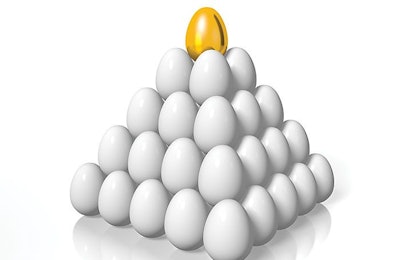
Wholesale egg prices in the U.S. returned to profitable levels for egg producers in the fall of 2017. The laying hen losses from 2015 highly pathogenic avian influenza outbreak led to record high egg prices in the U.S. The record profits and the cage-free purchase pledges made by retail and restaurant chains led to a significant expansion in total layer numbers in the U.S. in general and cage-free layers in particular. Wholesale egg prices reached historic lows in the late spring and early summer of 2016.
1. How much will egg production increase in 2018?
The Egg Industry Center’s December 6, 2017, Flock Trends and Projections report estimated that the U.S. layer flock would total 319.4 million hens on December 31, 2017. The December 11, 2017 USDA World Agriculture Supply and Demand Estimates (WASDE) report projects a 2.1 percent increase in eggs available for U.S. consumers to eat in 2018. This same report estimates that the wholesale New York Grade A large egg price 2017 will come in at $1.003 per dozen and that the average will fall between $1.00 and $1.07 in 2018.
In essence, the USDA is projecting a 3.9 egg increase in per capita egg consumption in the U.S. in 2018 with either no change or a slight increase in the wholesale price of eggs. Given that demand for eggs is highly inelastic, this price projection may be optimistic. A real increase in demand would be required for this to be the case.
Dr. Thomas Elam, economist, FarmEcon LLC, said, “Given where the laying flock and (egg) prices are today I do not see production growing at quite the USDA projected rate, from 1-1.5 percent would be my projection. Recent announcements on slowing down cage free expansion also reflect the slow growth in consumer demand in the retail space. Foodservice is in a better position to dictate production practices as eggs are generally a very low proportion of their overall commodity costs.”

2. Will feed cost decline in 2018?
For the 2016/2017 crop year, the estimated average corn price received by farmers was $3.36 per bushel according to the December WASDE report. The USDA estimates that corn prices will average somewhere in the range of $2.85-$3.55 per bushel for the 2017/2018 crop year.
The December USDA WASDE report estimates the average price farm price for soybeans for the 2016/2017 crop year at $9.47 per bushel and predicts that the soybean price will average somewhere in the range of $8.60-10.00 per bushel for the 2017/2018 crop year.
“I believe that corn and soybean meal prices are close to the bottom of the cycle,” said Dr. Paul Aho, economist, Poultry Perspective. “The top of the cycle was back in 2012 when there was a powerful incentive to produce more grain around the world combined with a powerful incentive to use less grain. Now the situation is reversed, lower prices mean that there is a weaker incentive to produce and a stronger incentive to consume.”
“Although prices may continue to drift lower, we are close to the bottom of the cycle and far from the top of the cycle,” Aho said. “If there are any surprises they are likely to be surprises that increase prices not decrease prices. If there are no surprises prices will eventually move higher. For some farmers current prices are unsustainable for others current prices are profitable. At the top of the cycle all farmers are profitable.”
Elam said, “I’ll go with USDA on corn and bean meal crop year midpoint price projections. Both are sustainable for anyone who cash rents only if rents are aligned with those prices. Sadly, that is not the case for many in spite of years of lower prices.”

3. Will NAFTA renegotiations impact egg producers?
The Trump administration concluded a fifth round of renegotiations of the North American Free Trade Agreement (NAFTA) in November of 2017. This treaty between the U.S., Mexico and Canada has played a major role in opening trade for goods between the three countries since its adoption in 1994. When asked what impact the NAFTA talks might have on egg trade, Elam said, “NAFTA negotiations will have little impact on the egg market, but could have a minor negative impact on corn exports and prices if as a result Mexico elects to reduce imports.”
Aho expressed concern over what might happen with overall agricultural trade between the three NAFTA nations as a result of renegotiation of the treaty. “For agriculture it would be best for nothing to happen to NAFTA,” he said. “NAFTA is like the fragile vase in the china shop when the bull comes charging through the door. I would hope the bull leaves the shop without breaking that particular vase, it would be best for nothing to happen to that particular vase and yet there is that bull and he has not yet decided to leave the shop.”


















